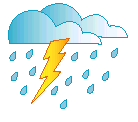 |
Weathering
the Games
by CORALIE ALDER |
Think the athletes are under pressure? Try predicting Salt Lake City’s weather in February.
 Clear
skies. Cold temperatures. Artificial snow. These are optimal weather conditions
for the fast slopes desired by Olympic skiers.
Clear
skies. Cold temperatures. Artificial snow. These are optimal weather conditions
for the fast slopes desired by Olympic skiers.
Nonetheless, these conditions may not be in the forecast for the 2002
Olympic Winter Games. What is in the forecast, however, are some of the
most up-to-date weather prediction teams and equipment ever assembled
for the Olympic Games.
The University of Utah’s meteorology department has teamed up with
the National Weather Service (NWS), the Salt Lake Organizing Committee
(SLOC), and KSL-TV, led by Mark Eubank BS’71, to provide timely and
accurate weather forecasts during the Games. The team will be responsible
for monitoring weather conditions not only at the five outdoor venues,
but also along the transportation routes leading to and from those venues.
This collaboration among public, private, and academic institutions is
a first for the Olympics.
Since the announcement in 1995 that Salt Lake City would host the 2002
Olympic Winter Games, faculty and  students
in the U’s meteorology department have been focusing on weather support.
With the assistance of federal funding, professors John Horel and Jim
Steenburgh, and Larry Dunn BS’79 PhD’93 from the NWS arranged
for the installation of 27 weather stations at the Olympic outdoor venues
and significantly increased the data available in the U’s MesoWest,
an online database that displays weather observations. Research Associate
Mike Splitt, who obtains and processes data from 70 cooperating organizations
in the western states, manages MesoWest.
students
in the U’s meteorology department have been focusing on weather support.
With the assistance of federal funding, professors John Horel and Jim
Steenburgh, and Larry Dunn BS’79 PhD’93 from the NWS arranged
for the installation of 27 weather stations at the Olympic outdoor venues
and significantly increased the data available in the U’s MesoWest,
an online database that displays weather observations. Research Associate
Mike Splitt, who obtains and processes data from 70 cooperating organizations
in the western states, manages MesoWest.
With the aid of graduate students, the group has conducted research to
improve knowledge of winter weather inmountainous areas and produce high-resolution
computer analysis and forecast models, which will provide hour-by-hour
forecasts at the venues throughout the Games. They’ve also provided
training for the forecasters who will be at the Olympic Weather Operations
Center and the outdoor venues.
 “The
development of improved weather monitoring and computer forecasting capabilities
has applications that extend beyond the Olympics,” says Steenburgh.
“For example, the dense array of wind observations we collect can
be used to identify opportunities for wind power development. Road surface
conditions can be better predicted, resulting in more efficient removal
of snow and ice during winter storms. Improved prediction of mountain
snowstorms and high-wind events provides valuable information for avalanche
prediction and control.”
“The
development of improved weather monitoring and computer forecasting capabilities
has applications that extend beyond the Olympics,” says Steenburgh.
“For example, the dense array of wind observations we collect can
be used to identify opportunities for wind power development. Road surface
conditions can be better predicted, resulting in more efficient removal
of snow and ice during winter storms. Improved prediction of mountain
snowstorms and high-wind events provides valuable information for avalanche
prediction and control.”
More than 20 University meteorology students will get hands-on experience
with the high-tech monitoring as volunteer weather aides at the Games
venues. They will be responsible for measuring snow-surface temperatures
and sky conditions, which will then be combined with automated observations
from the weather sensors installed by Horel and his team to produce the
official weather observation for all outdoor Olympic events. This once-in-a-lifetime
experience will be invaluable to the students in their development as
meteorologists.
Most important, the development of the weather equipment and the knowledge
gained over the past few years and during the Games will improve forecasting
in Utah. According to U meteorologist and SLOC’s weather coordinator
Tom Potter, “The Olympic weather support project will leave a lasting
legacy of more weather instruments at key mountain locations, improved
databases for future researchers, better forecasting tools, and improved
understanding of complex weather processes in complex terrains—all
leading to much better forecasts in the Intermountain region for years
to come.”
—Coralie Alder is director of public relations at the University.
For more information about the meteorology project and weather forecasting,
visit www.met.utah.edu
![]()